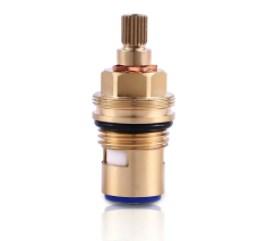The ceramic valve core is a small but critical component in the realm of fluid control, playing a significant role in the efficient use of water resources. As the world faces increasing water scarcity, the importance of water conservation has become more prominent. The integration of ceramic valve cores in various applications can contribute significantly to reducing water waste through their precision, durability, and reliability.
Water conservation is not just a matter of environmental stewardship; it is also an economic and social necessity. Inefficient water use can lead to higher utility bills, strain on water supply systems, and even contribute to the depletion of natural water sources. Ceramic valve cores, with their unique properties, can help mitigate these issues in several ways.
Firstly, the precision engineering of ceramic valve cores allows for fine-tuning of water flow. This means that water can be delivered exactly where and when it is needed, without the excess flow that leads to waste. In faucets and showerheads, for example, a ceramic valve core can ensure that the water flow is controlled to the optimal level, reducing the amount of water used during each shower or hand wash.
Secondly, the durability of ceramic materials means that valve cores can withstand the wear and tear of regular use without degrading. This longevity reduces the need for frequent replacements, which can be a source of water waste when old, less efficient components are used. A ceramic valve core can maintain its sealing properties for an extended period, ensuring that no water is lost due to leaks or faulty operation.
Thirdly, ceramic valve cores are resistant to corrosion and deposits, which can affect the performance of valves in water systems. By maintaining a high level of performance over time, ceramic valve cores help to prevent drips and leaks that can occur when other materials are used. This corrosion resistance also means that ceramic valve cores can be used in water systems with aggressive or contaminated water without the risk of damage, further reducing the potential for water waste.
Moreover, the use of ceramic valve cores in irrigation systems can lead to significant water savings. These valve cores can be integrated into smart irrigation systems that use sensors to detect soil moisture levels and adjust water delivery accordingly. This ensures that water is only used when and where it is needed, avoiding overwatering and the waste of precious water resources.
In industrial applications, ceramic valve cores can also play a crucial role in water conservation. In processes where water is used as a coolant or for cleaning, precise control of water flow provided by ceramic valve cores can reduce overall consumption. By ensuring that only the right amount of water is used at the right time, industries can cut down on their water usage and costs, while also reducing their environmental impact.
Furthermore, the implementation of ceramic valve cores in water treatment plants can enhance the efficiency of water purification processes. By providing tight seals and precise control over water flow, these valve cores can help to minimize water loss during the treatment process. This not only conserves water but also ensures that more of the treated water is available for consumption or other uses.
In conclusion, ceramic valve cores are a vital component in the fight against water waste. Their precision, durability, and resistance to corrosion make them an ideal choice for applications where water conservation is a priority. By ensuring that water is used efficiently and effectively, ceramic valve cores contribute to a more sustainable future where water resources are preserved for generations to come.



